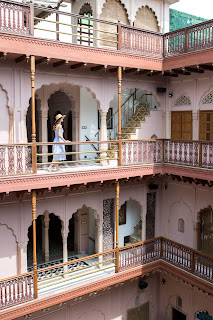Quite common in the north Indian states like Rajasthan, Haryana, etc are big traditional town houses with a courtyard. They are historically and architecturally rich large mansions designed to be closed from all sides with just one entrance gate, providing a community living space for several generations as part of a joint family unit. Commonly known as Haveli with no architectural affiliation, the big home with a courtyard or two (Courtyard is central to the house) is ingeniously designed to live comfortably in different climatic conditions. Quite airy and well ventilated, the interiors will be cooler during the day regardless of hot weather outside. The arcade along the court, or the high wall around it has an advantage. It will keep indoors cool. Perforated or lattice windows in the façade with a shade over it, will allow filtered light inside during the day and further cool the interior. Apart, havelis were built with a view to providing security and privacy. Of course as mentioned before the design gave due importance to vagaries of weather and the unforgiving heat and provided adequate ventilation. The concept of haveli meaning ''private space" quite popular in the northern part of the Indian subcontinent has been around since the Mogul period.
 |
| Patwon Ji Ki Haveli, Jaisalmer, Rajasthan,upload.wikimedia.org |
Normally, it had long been a tradition in the Indian subcontinent to have a house built around a courtyard not only to tackle the hot tropical climate with proper ventilation but also to provide a space for all family activities around this chowk or courtyard.Above image: Vivaana Culture Hotel restored and preserved the original features of two havelis.
 |
| Restored haveli, Vivaana Culture Hotel edition.cnn.com |
 |
| Dharampura haveli Delhi. in.pinterest.com |
The courtyard in the home promotes frequent interaction and integration among families living under one space and, further, it serves as a relaxing space for family functions, celebrations etc. In the later years haveli is referred to as a big mansions of different styles. The construction materials that go into Haveli are fired bricks, sandstone, marble, wood, lime plaster, and granite, etc. Decoration of haveli may vary depending on the influence of various local cultures and traditions. The nature and quality of design, etc is dependent on the financial budget of the builder. Some havelis have decorative features like frescoes, murals, inlays and artwork.; the rich décor may include engraved dark wood furniture, chandeliers, rugs ,etc. Places like Jaisalmer, Udaipur, Shekhawati and Jodhpur of Rajasthan and Delhi are known to have amazing havelis in India. Today, Shekhawati region has a cluster of more than 2,000 painted havelis trying hard to retain the past glory. .
 |
| An abandened haveli susannarosenphotography.com |
In the case of wealthy people owning rich haveli with multistory structure as in Rajasthan, there will be two courtyards around the structure. The rich outer courtyard is strictly reserved for meetings and trade while the inner courtyard is home to a large extended family. Now some havelis have been converted into hotels or museums.
 |
| Chunnamal haveli, Delhi navinajafa.wordpress.com |
Moguls during their heyday took this traditional Hindu home design and blended it with Islamic style such as jaalis, Jharokha, etc. In the later years the other Indian communities started adopting it when they built big mansions
The advantage of havelis with a court yard are many:
01. The central courtyard provides natural ventilation and flow of clean air into the interior parts.
02. The courtyard or Chowk acts as a venue for family functions or some religious rituals or weddings.
03 The partitioned courtyard with jaalis gives privacy as well as free interaction to women living in the haveli.
04. The inhabitants have a secured feeling living in the middle of many families within a safe enclosure.
05. For men and women there is an ample scope for sharing their personal joy and sorrow with others in the mansion. Psychologically it will help them a lot.
06. More than century old Havelis, predominantly owned by wealthy Marwari community in India, are architecturally opulent m adorned with frescoes so exquisite that they've become a tourist attraction.
Thus various aspects make the living in a haveli quite comfortable and safe. For many rich families of Rajasthan and other places it became a status symbol to have a self contained large architecturally rich haveli - a sort of home for their extended family. The advantages are they provide comfort and security in seclusion from the madding outside world. It also offers extra security as the haveli is designed to be closed from all sides with one large main gate. It means it is difficult for a stranger to access it. Some havelis may have more than one courtyard.
With the passage of time and advent of modern facilities and comforts of living in gated high-rise buildings, most of the havelis are empty now and being taken care of by watchmen. Some are turned into hotels.
Many beautiful ‘havelis’ of Old Delhi, 'fragile and frangible' reminders of the city’s glorious past', are either crumbling or faded into insignificance unable to confront urban din, the dust of maddening crowds and the chaos of traffic and commercial activities. In many place the Colonial period havelis lie hidden in the midst of mad construction projects, With damaged façade, rickety stairway, broken jharokha, etc., the decrepit condition of the glorious havelis may overwhelm you. They lie uncared for and forgotten reminding us of the transitory aspect of our life and the things around us.
This is also true of big Chettinad Mansions of Tamil Nadu owned by rich Chettiyar community (mostly they were financiers and bankers). These large architecturally rich Chettinad mansions in and around Karaikudi town are being maintained by the descendants of the family with considerable strain. The maintenance and repair costs are prohibitive nowadays. Some Chettinad house have been converted into posh hotels.
https://en.wikipedia.org/wiki/Haveli
https://www.deccanherald.com/content/534122/vanishing-legacy.html
https://roofandfloor.thehindu.com/real-estate-blog/the-regal-mystique-of-havelis/
https://edition.cnn.com/travel/article/india-haveli-painted-mansions/index.html









